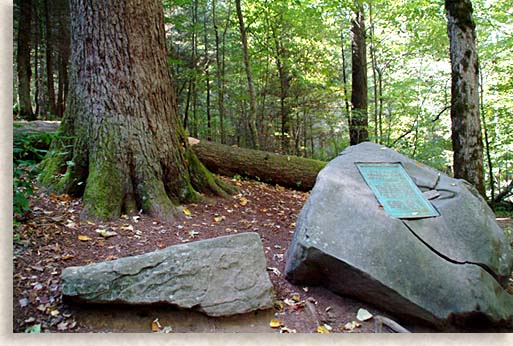
Joyce Kilmer Memorial Forest
Trees, Patriot and Poet
I think that I shall never see
A poem lovely as a tree
Joyce Kilmer
Lost within a mountain forest, locked away from the world and hidden along the Little Santeetlah Creek watershed is a rare woodland paradise. Protected from the outside world, held within an eternal sanctuary of peace, solitude and magnificent grandeur of the “old growth forest,” are the ancient giants trees, standing as monuments to life and time. In the far away Unicoi Mountains of western North Carolina’s Nantahala National Forest and eastern Tennessee’s Cherokee National Forest is a remote and nearly isolated 17,013-acre tract of virgin forest…the Joyce Kilmer Memorial Forest and Slickrock Wilderness Area.
Set aside by the U.S. Forest Service, this forest and wilderness area serves the public as a protected preserve and as an evident example of what eastern North American forest looked like when the first European arrived in this New World.
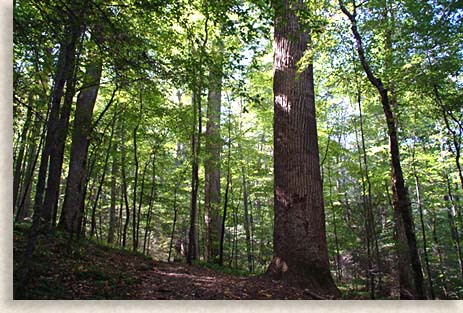 Prior to the founding of the U.S. Forest Service, around the turn of the 20th century, many natural forested landscapes in North American were to be lost due to uncontrolled exploitation and abuse of their natural resource. Most forestlands in America were either owned or leased by individuals, mostly lumber companies whose model was “the only good tree was a cut tree.” Entire forests were falling at an alarming rate for decades before the word “environmentalist” ever existed.
Prior to the founding of the U.S. Forest Service, around the turn of the 20th century, many natural forested landscapes in North American were to be lost due to uncontrolled exploitation and abuse of their natural resource. Most forestlands in America were either owned or leased by individuals, mostly lumber companies whose model was “the only good tree was a cut tree.” Entire forests were falling at an alarming rate for decades before the word “environmentalist” ever existed.
Concerned individuals appealed to the government during this time to protect these precious forests from total annihilation, which lead to the eventual creation of the U.S. Forest Service. The mountains and valleys of Appalachia were swept clean by the saw blade leaving once forested landscapes barren in the wake of a wood resource product frenzy. Gone within a couple of generation were entire virgin forests, to satisfy a young nation's growth.
As World War I raged on in Europe with lives being lost in the 10’s of thousands, so was the war on forestlands intensifying back home in the backwoods of the United 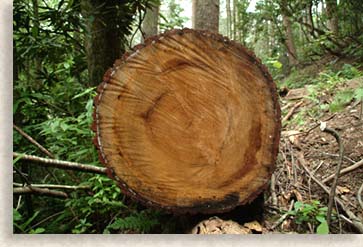 States, with the systematic plan of harvest (destruction) of their natural resource. With so much virgin forest gone, the U.S. Forest Service had to search out any remnants of virgin old growth forest that were left in order to manage and preserve them, as well as build and replant new forests where the old harvested forest once stood.
States, with the systematic plan of harvest (destruction) of their natural resource. With so much virgin forest gone, the U.S. Forest Service had to search out any remnants of virgin old growth forest that were left in order to manage and preserve them, as well as build and replant new forests where the old harvested forest once stood.
Several scattered tracts of hard to reach virgin forest still existed in the early 20th century with two of the largest stands in Western North Carolina and Eastern Tennessee mountains. One of these great stands is the 100,000-acres of virgin forest that just so happens to be in the Great Smoky Mountain National Park. The location of the large old growth forest led to the final choice as to where the United States Forest Service would create its treasured eastern national park known today as the Great Smoky Mountains National Park.
The second largest tract of old growth virgin forest chosen by the U.S. Forest Service is the 17,013-acre Joyce Kilmer Memorial Forest and Slickrock Wilderness Area, named after the famous American poet and acclaimed author of “Trees.”
1934 - US Forest Service on a Mission
In 1934, a New York chapter of the Veterans of Foreign Wars approached the federal government with a petition, requesting that the government honor Joyce Kilmer, a fallen comrade and fellow patriot with a suitable memorial. After discussing the petition with the government, it was decided that an appropriate memorial for the patriot poet would be a tract of virgin forest in the eastern United States.
The U.S. Forest Service was assigned the task of finding a needle in a haystack. A rare jewel; tuck away deep in the far reaches of western North Carolina’s mountain country. What they found was a virgin forest of giant trees just waiting to be saved.
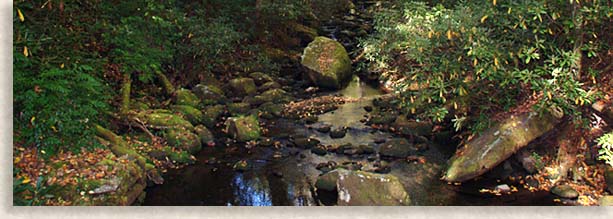
In a large mountain cove next to the Slickrock Creek watershed, along the Little Santeetlah Creek they found a forested land that was completely intact, natural to its origins, an ancient oasis surrounded by mountainous lands that had already been devoured by the logger saw’s insatiable hunger. Threatened with total destruction, were the virgin forestlands within the Little Santeetlah Creek basin, with trees over 400-years old that ranged from 100 to 150 feet tall and 15 to 20 feet in circumference.
After much bargaining, the U.S. Forest Service finally arranged to purchase 13,055 acres of the Little Santeetlah basin from the Gennett Lumber Company for an outrageous price of $28 dollars per acre; a high price in 1935 considering local land prices at the time sold for $4 dollars an acre. Such was the importance for acquiring this piece of property that is now considered a national treasure.
Several unforeseen circumstances occurred causing this precious virgin woodland to escape the saw for 46 years. Over that length of time the land of the Little Santeetlah Creek basin changed owners several times, each with the intent of logging the valuable giant trees, each with the overwhelming task of doing so within the very remote and difficult terrain.
What stopped the harvest were the construction of two local lakes, Lake Santeetlah and Lake Calderwood. The railways were not able to remove the trees due to the flooding of these lakes, which shut down rail traffic.
The logging company then constructed splash dams to float the trees out, yet before they could be used the logging company went bankrupt. The bankruptcy was cause by the drop in lumber prices in 1929.
Some believe that even though the timber owners first saw dollar signs, they were “awe struck” by the beauty and majesty of the giant trees. Regardless how 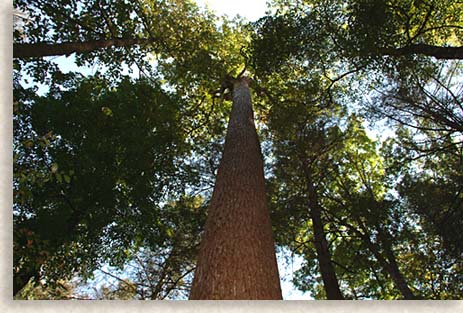 awe inspired some of the logging companies might have been with these majestic trees, eventually they would have resorted to "business is business" and found a way to harvest the trees and get them to the market.
awe inspired some of the logging companies might have been with these majestic trees, eventually they would have resorted to "business is business" and found a way to harvest the trees and get them to the market.
Thankfully, the logging companies had been mysteriously held off from harvesting these trees until an unexpected time came when the protectors of the forest, the U.S. Forest Service could step in and save this rare ancient woodland.
Of the first 13,055-acres purchased by the U.S. Forest Service along the Little Santeetlah Creek basin, 3,840-acres were designated as a protected preserve, dedicated as the Joyce Kilmer Memorial Forest on July 30, 1936 and opened to the public.
Today the Joyce Kilmer Memorial Forest and Slickrock Wilderness Area has grown to 17,013-acres spanning into two states, the majority of the steep forested mountains are in the Nantahala National Forest in Graham County, North Carolina. About 3,900-acres of the forest are over the mountain ridge are in the Cherokee National Forest of Monroe County, Tennessee.
Visit Joyce Kilmer Memorial Forest • Joyce Kilmer - Patriot Poet
History of Joyce Kilmer Memorial Forest • Nearby Points of Interest
![]()
Sign
up for the Blue Ridge Highlander Newsletter, Messages from the Mountains
to find out first about our new feature stories, road trips and special offers
Your e-mail addresses will not be sold or given away to anyone.
Privacy
Policy
Interested in your business being on the Highlander, click here...
Let our visitors tell you about the Highlander...
Click the feathers to go to the Highlander site
map...

